Designing Desert-Themed Rooms for Pet Snakes
Designing a desert-themed room for your pet snake can be a blast! First, pick a spacious glass enclosure—sorry, cardboard just won’t cut it. Fill it with natural substrates like sand and add decorative faux cacti. Don’t skimp on hiding spots or climbing areas, because let’s face it, snakes love to explore! And recall to keep the temperature between 75-95°F, with a bit of humidity. Ready to create a mini desert oasis for your scaly friend? Trust me, there’s more to discover!
Quick Takeaways
- Select a spacious glass or sturdy plastic enclosure to promote exploration and comfort for your pet snake.
- Use naturalistic substrates like sand and coconut fiber to mimic a desert-like environment.
- Maintain adequate temperature ranges with cool zones at 75-85°F and basking spots between 85-95°F.
- Incorporate hiding spots using rocks and logs, alongside climbing areas with shelves or branches for engagement.
- Enhance aesthetics with live plants like succulents and hardy cacti, while ensuring safety for your snake.
Selecting the Right Enclosure for Desert Habitats
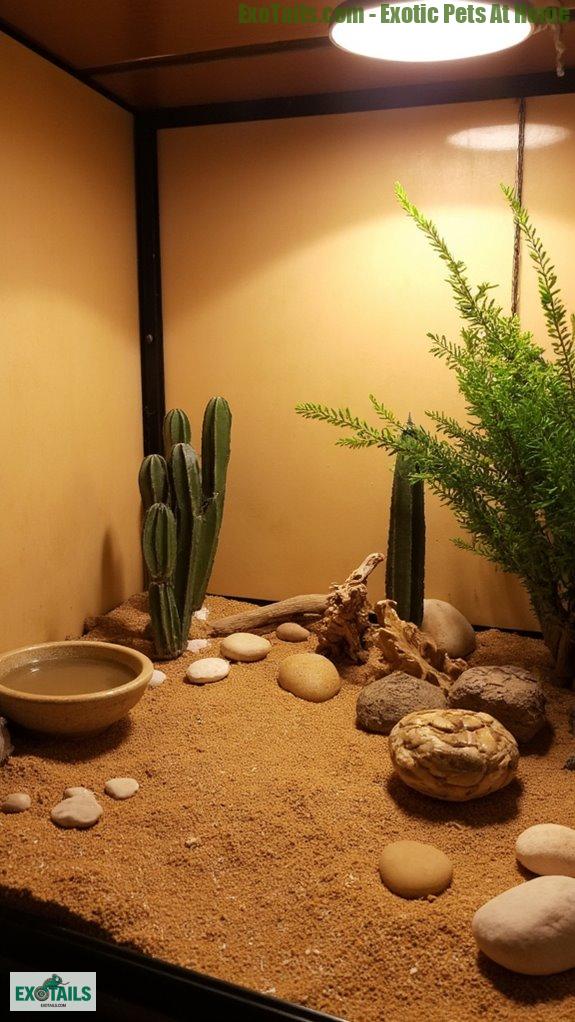
When it comes to selecting the right enclosure for desert habitats, you’ll want to evaluate what makes your pet snake feel at home in a place that’s often a bit dry and sandy.
Is your snake a true Size Queen?
A larger enclosure size gives them room to slither and explore, while the right enclosure materials—maybe glass or sturdy plastic—add that touch of class to their abode.
I learned that the hard way after trying a cardboard box—I can’t believe my snake didn’t send me a thank-you note!
Incorporating Naturalistic Substrate and Décor
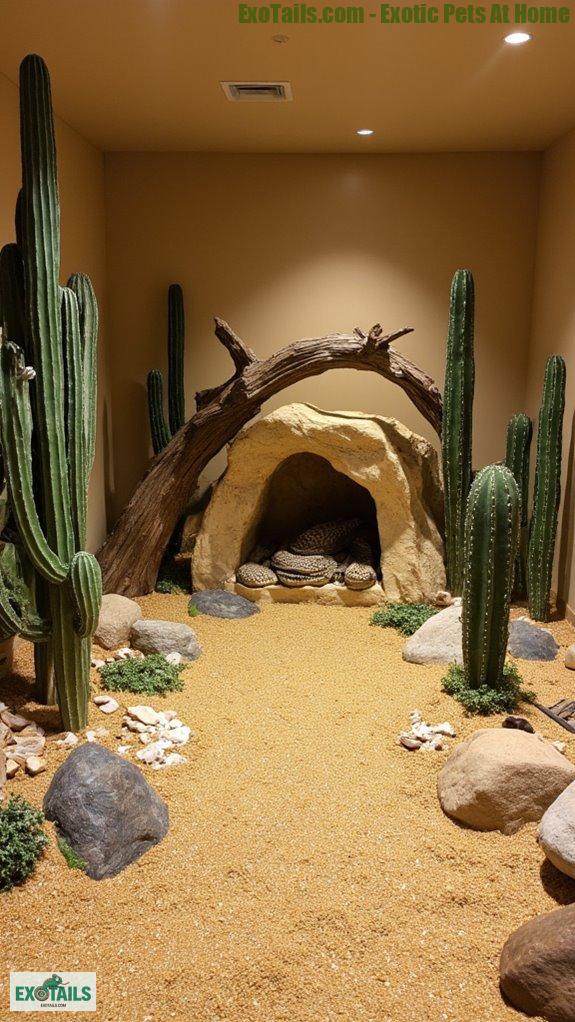
After settling on the perfect enclosure for your desert-dwelling snake, it’s time to transform that box into a mini desert oasis.
Think of it like an interior design gig—minus the sassy TV hosts and fancy budgets.
Start by choosing naturalistic textures for your substrate types; I’m talking sand, reptile carpet, or coconut fiber.
Your snake will love gliding through these textures like it’s on a sandy vacation.
Your snake will experience pure bliss, sliding through their sandy paradise like a true desert explorer!
Don’t forget to throw in decorations like fake cacti and rocks; they’ll feel right at home.
Who knew being a snake parent would double as a desert décor magician?
Welcome to ExoTails, my wild ride!
Optimizing Temperature and Humidity Levels

To keep your desert-themed room thriving, you’ve got to nail the right temperature and humidity levels—because let’s be real, no one wants a cranky snake, right?
Here’s a quick guide to help you conquer temperature regulation and humidity control:
- Temperature range: Aim for 75-85°F on the cool side, and 85-95°F basking spot.
- Thermometers: Use digital ones for accurate readings.
- Humidity: Keep it around 30-50%—not a swampy jungle, just a hint of desert moisture!
- Misting technique: Lightly mist a small area; your snake isn’t auditioning for a spa day.
Trust me, your snakes will thank you!
Creating Functional Hiding Spots and Climbing Areas
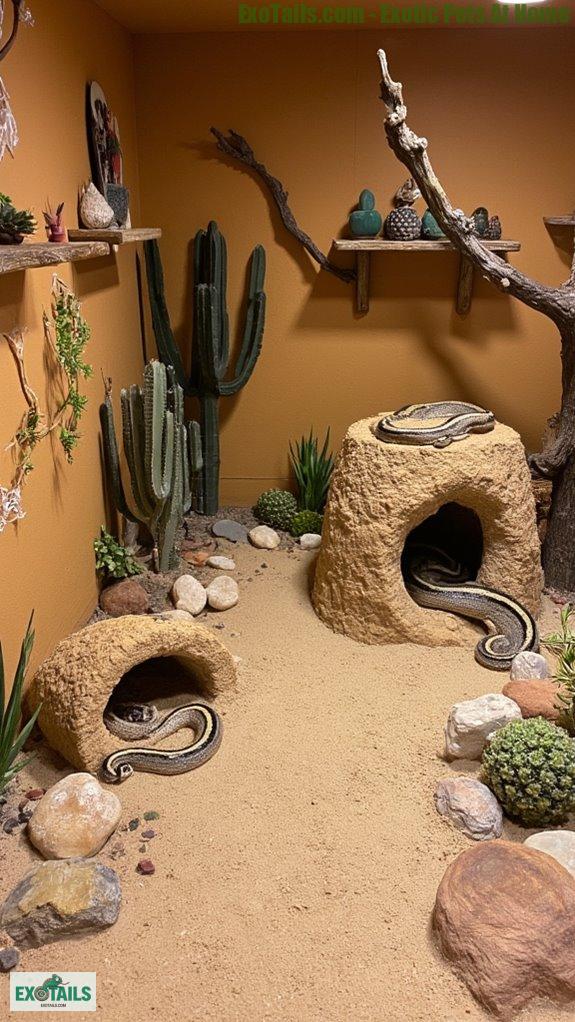
Creating a desert kingdom for your pet snake isn’t just about getting temperatures and humidity right—it’s also about giving them cozy spots to hide out and some elevated areas to explore.
Ever notice how snakes love their hiding behaviors? It’s like they’re secret agents on a mission! A few strategically placed hides like rocks, logs, or cork bark can provide perfect retreats.
And let’s not forget their climbing preferences! Adding shelves or branches encourages them to slither high—because who doesn’t love a good view?
Trust me, your snake will thank you, because happy snakes make for happier owners, right?
Choosing Suitable Plants and Foliage
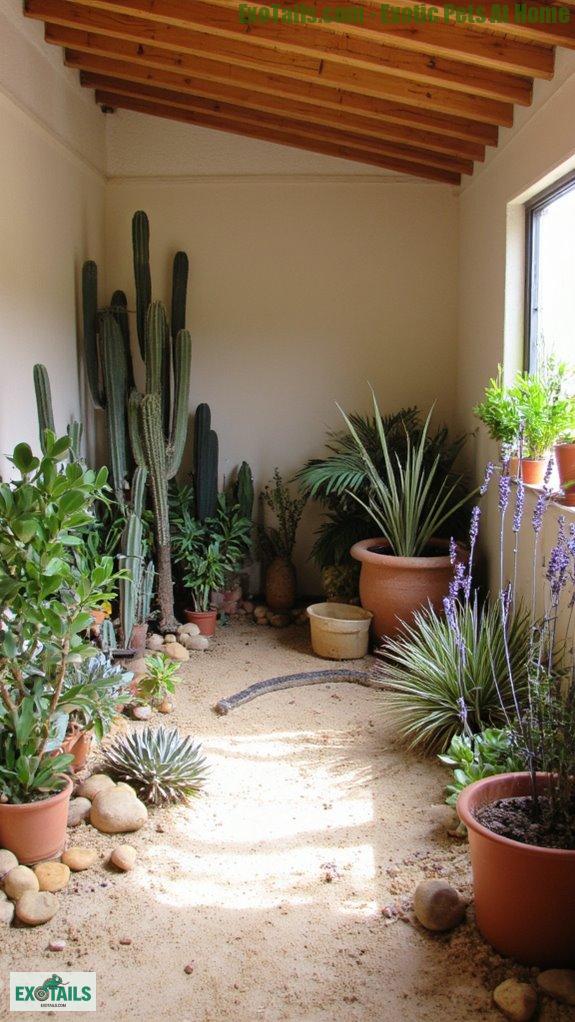
While it might seem tempting to throw in some plastic plants for decoration, choosing suitable live plants can really transform your snake’s desert habitat into a lively oasis.
Plus, who doesn’t love a bit of greenery?
Here are some eco-friendly options featuring native species:
- Succulents – Good for hiding, plus they look fabulous!
- Cacti – Tough little guys that can take a poke.
- Desert Grasses – Soft beds for your slithery friend.
- Lavender – A fragrant touch, but not too close to the snake!
Trust me, your snake’s home needs some pizzazz, and these plants are the way to go!
Enhancing Lighting for a Desert Environment
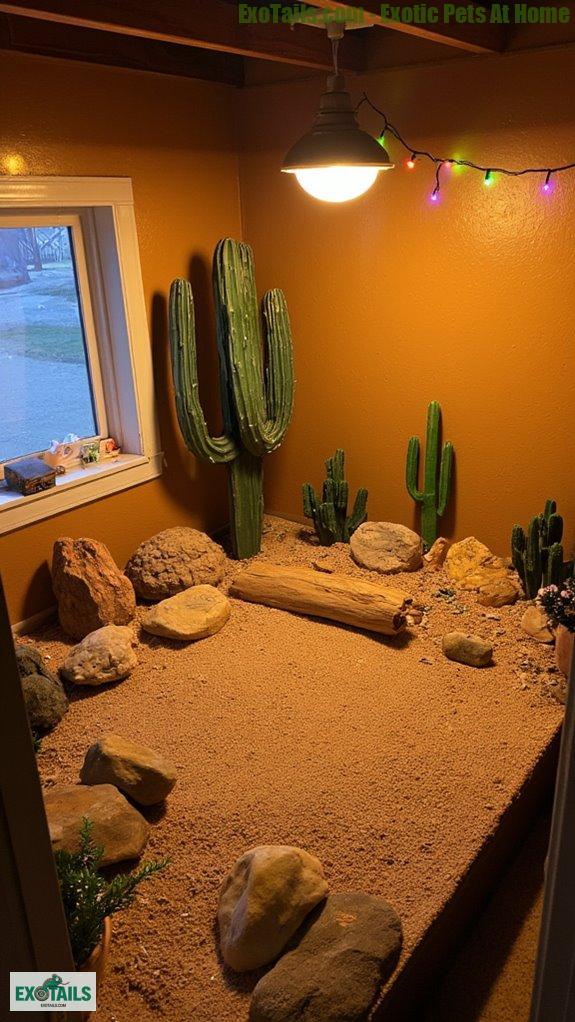
A well-designed desert-themed room for your snake isn’t just about the plants; lighting plays a big role too!
Think LED lighting, which not only brightens up the space but also boosts your snake’s mood like a sunbather on a tropical getaway.
Remember the UVB exposure! It’s essential for your scaly friend’s health, and just like your cousin’s tan, it needs to be both smart and safe.
Unique Reptile Habitats Indoors

When I think about unique reptile habitats indoors, I can’t help but get excited about all the cool possibilities.
Creating unique indoor habitats for reptiles is an exhilarating journey filled with endless creative possibilities!
Who knew creating a comfy home for our cold-blooded buddies could be this fun?
Here are four ideas to get your creative juices flowing:
- Desert Oasis: Incorporate sand, rocks, and succulents for natural behaviors.
- Rainforest Retreat: Mimic a jungle with vines and humidifiers for habitat enrichment.
- Cave Den: A cool hideout with caves for secretive shenanigans.
- Aquatic Escape: A shallow water feature for splashy adventures—just don’t confuse them with an axolotl!
Creating a balanced environment is essential for your reptiles’ health and wellbeing, so consider the importance of bioactive enclosures in your designs.
Ready to transform your space?
My Aquatic Axolotl Buddy
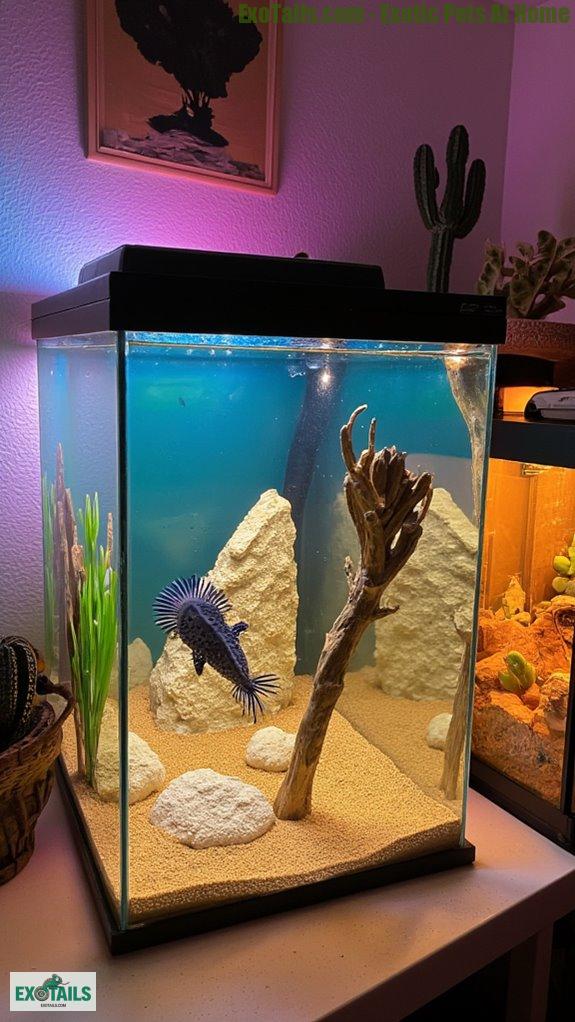
If you’ve never met an axolotl, let me introduce you to my aquatic buddy, the unique and utterly charming creature that swims through my heart and my aquarium!
These quirky amphibians are basically the superheroes of the aquatic environment, sporting frilly gills and a permanent goofy grin.
When it comes to axolotl care, keep the water clean, and don’t forget they prefer cooler temps—no hot tubs for them! Additionally, maintaining a proper pH level in their tank is crucial for their health and well-being.
Having designed numerous exotic habitats, I can confidently say my axolotl showcases the perfect blend of charm and personality.
Seriously, who could resist a creature that looks like it’s perpetually smiling?
Questions and Answers
Can I Use Real Cacti in My Snake’s Enclosure?
Can you use real cacti in your snake’s enclosure? I’ve found it’s a prickly dilemma! While they look cool, they can harm your snake’s health. Opt for fake ones—safer and no cactus injuries to worry about!
How Often Should I Clean My Snake’s Desert Habitat?
Cleaning my snake’s desert habitat feels like preparing for a royal banquet! I tackle snake habitat maintenance every week, ensuring it’s spotless and helps with desert temperature regulation. Snakes deserve their five-star digs, after all!
What Bedding Materials Are Toxic to Snakes?
I can’t believe how many snake owners overlook toxic materials in bedding! We’ve got options like aspen shavings or coconut coir. Just steer clear of cedar or pine—my snakes don’t appreciate a dramatic flair!
Can I Use Artificial Plants in a Desert Setup?
Sure, I can use artificial plants! They’re like the stylish, low-maintenance friends of the plant world, brightening up my desert vibe. Just make sure they’re snake-safe—those plastic cacti won’t snap back if my snake gets curious!
Do Snakes Need UVB Lighting in Desert-Themed Rooms?
Do snakes need UVB lighting? Well, I’d say it’s as important as my morning coffee! It helps with their behavior, like basking—just envision a snake sunbathing like a beachgoer, right? Who wouldn’t want that?







